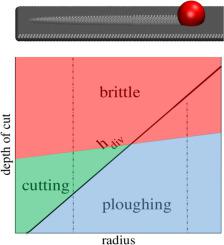Our official English website, www.x-mol.net, welcomes your feedback! (Note: you will need to create a separate account there.)
Wear at an incipient ploughing–cutting transition
Wear ( IF 5 ) Pub Date : 2024-04-02 , DOI: 10.1016/j.wear.2024.205354 Rosario Capozza , Kevin J. Hanley
Wear ( IF 5 ) Pub Date : 2024-04-02 , DOI: 10.1016/j.wear.2024.205354 Rosario Capozza , Kevin J. Hanley

|
Ductile wear is highly desirable in manufacturing and machining operations to achieve a high quality of finish. In a ductile regime of operation, a characteristic transition from ploughing to cutting is often observed in materials with different mechanical properties. We unveil the origin of this transition through a plastic, debris-free model of a tip causing wearing of a flat surface. The abraded volume depends on the equilibrium depth which is reached once the normal force is balanced by the lifting force during scratching. We show that the dependence of the equilibrium depth on the lifting force is highly non-linear and diverges above a threshold force that depends on the hardness, friction force and geometry of the tip. The threshold corresponds to a characteristic depth marking the ploughing–cutting transition. When this characteristic depth is below the ductile–brittle depth of cut, ploughing, cutting and brittle modes of operation are all possible. These abrasive wear modes are summarised in a unified mechanism map. The findings of this model, derived from theoretical considerations, are validated by DEM simulations and literature data from experiments.
中文翻译:

早期犁耕-切割过渡时的磨损
在制造和机加工操作中,为了实现高质量的光洁度,非常需要延性磨损。在延性操作状态下,通常在具有不同机械性能的材料中观察到从犁耕到切削的特征转变。我们通过塑料、无碎片的尖端模型揭示了这种转变的起源,该模型导致平坦表面的磨损。磨损量取决于刮擦时法向力与提升力平衡时达到的平衡深度。我们表明,平衡深度对升力的依赖性是高度非线性的,并且偏离阈值力,该阈值力取决于尖端的硬度、摩擦力和几何形状。该阈值对应于标记犁耕-切割过渡的特征深度。当该特征深度低于延性-脆性切削深度时,犁耕、切削和脆性操作模式都是可能的。这些磨料磨损模式被总结在统一的机制图中。该模型的研究结果源于理论考虑,并通过 DEM 模拟和实验文献数据进行了验证。
更新日期:2024-04-02
中文翻译:

早期犁耕-切割过渡时的磨损
在制造和机加工操作中,为了实现高质量的光洁度,非常需要延性磨损。在延性操作状态下,通常在具有不同机械性能的材料中观察到从犁耕到切削的特征转变。我们通过塑料、无碎片的尖端模型揭示了这种转变的起源,该模型导致平坦表面的磨损。磨损量取决于刮擦时法向力与提升力平衡时达到的平衡深度。我们表明,平衡深度对升力的依赖性是高度非线性的,并且偏离阈值力,该阈值力取决于尖端的硬度、摩擦力和几何形状。该阈值对应于标记犁耕-切割过渡的特征深度。当该特征深度低于延性-脆性切削深度时,犁耕、切削和脆性操作模式都是可能的。这些磨料磨损模式被总结在统一的机制图中。该模型的研究结果源于理论考虑,并通过 DEM 模拟和实验文献数据进行了验证。



























 京公网安备 11010802027423号
京公网安备 11010802027423号